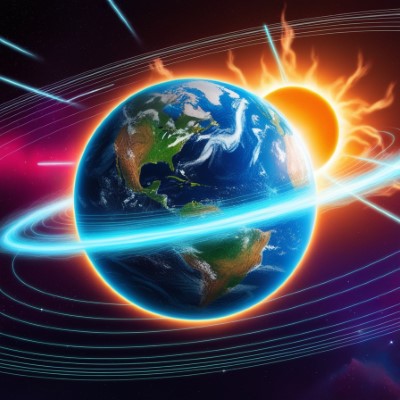Have you ever wondered what keeps life on Earth safe from the constant bombardment of harmful solar particles? Every second, the Sun unleashes streams of charged particles—known as the solar wind—racing toward our planet at millions of kilometers per hour. Yet, here we are, living comfortably without being fried by this cosmic storm. The unsung hero of this story? Earth’s magnetic field.
Let’s take a fascinating journey to understand how this invisible shield works, why it’s crucial for life, and what would happen if it disappeared.
What Exactly Is the Solar Wind?
The Sun is not just a glowing ball of gas—it’s a powerhouse constantly releasing streams of charged particles, mostly protons and electrons. This flow is called the solar wind. Sometimes, during solar storms or coronal mass ejections (CMEs), this wind becomes even more intense, carrying massive amounts of energy toward Earth.
Sounds scary, right? Without protection, these high-energy particles could strip away our atmosphere, fry electronics, and expose us to dangerous radiation. But luckily, Earth has a natural defense system.
Meet the Magnetic Field: Our Invisible Guardian
Earth’s magnetic field is generated deep within its core, where molten iron moves like a giant dynamo. This movement creates a geomagnetic field that extends far into space, forming what we call the magnetosphere.
Think of the magnetosphere as an invisible bubble that surrounds Earth. When the solar wind hits this bubble, it doesn’t just slam into our atmosphere—it’s deflected and redirected, like a cosmic force field.
How Does the Magnetosphere Work?
When the solar wind approaches, it interacts with the magnetosphere in a few key ways:
- Deflection of Charged Particles
Charged particles tend to follow magnetic field lines. As the solar wind reaches Earth, most of these particles are diverted around the planet, never reaching the surface. - Formation of a Bow Shock
Just like water flowing around a rock in a river, the solar wind slows down and forms a “bow shock” in front of the magnetosphere, reducing its intensity. - Particle Trapping
Some particles do sneak in, but they get trapped in the Van Allen radiation belts, circling harmlessly above our atmosphere instead of bombarding the surface. - Polar Light Show
A small fraction of particles enter near the polar regions, where the magnetic field lines converge. Here, they collide with atmospheric gases, creating the stunning auroras—nature’s very own light show!
What If Earth Didn’t Have a Magnetic Field?
Here’s where it gets real. Without the magnetic field:
- The solar wind would slowly strip away the atmosphere, like it did with Mars.
- Harmful cosmic radiation would reach the surface, making life far more dangerous.
- Satellites, power grids, and electronics would be far more vulnerable to damage.
In short, Earth would become a far less hospitable place.
The Dynamic Nature of the Magnetic Field
The magnetic field isn’t static. It shifts, wobbles, and even flips polarity every few hundred thousand years. Don’t worry—it doesn’t disappear during a flip; it just reorganizes. Still, these changes affect how the magnetosphere interacts with the solar wind.
Scientists keep a close eye on the field using satellites and ground-based observatories to understand its behavior and predict how it might change in the future.
Why This Matters Today
In our modern world, we rely on satellites for communication, navigation, and weather forecasting. A powerful solar storm could disrupt all of this, causing blackouts and chaos. Understanding Earth’s magnetic shield isn’t just science—it’s essential for protecting our technology and infrastructure.
Wrapping Up
So, the next time you see a beautiful aurora or read about a solar storm, remember the invisible shield that makes life on Earth possible. Our magnetic field quietly stands guard, deflecting deadly particles and ensuring our planet remains a safe haven in the harshness of space.
Fascinating, isn’t it? It’s like Earth has its very own superhero—silent, invisible, but absolutely vital.
